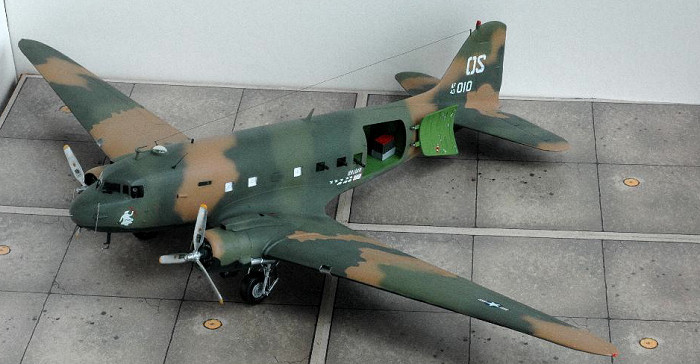
Monogram 1/48 AC-47
| KIT #: | 5607 |
| PRICE: | $24.98, now OOP |
| DECALS: | See review |
| REVIEWER: | Andrew Garcia |
| NOTES: | Cutting Edge conversion |

| HISTORY |
The
AC-47D Late Version with GE MXU-470, 7.62mm Guns was the
final version of the three types of C-47 transport aircraft converted into
Gunship aircraft. In the ever changing evolution of Gunships using the “side
fire” concept this one represents the
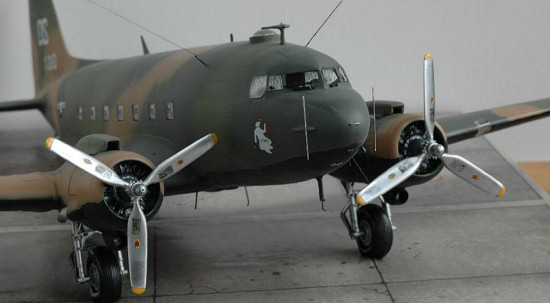 final version of the AC-47D gunship. This
aircraft incorporated the improvements that resulted from experience with the
first and second-generation AC-47 gunships. The essential changes were:
final version of the AC-47D gunship. This
aircraft incorporated the improvements that resulted from experience with the
first and second-generation AC-47 gunships. The essential changes were:
1) The opening of a new window next to the cargo door to improve storage space utilization, This resolved the problem of access/loading, which was affected by having one of the three miniguns sitting in the doorway of the prior version!
2) Use of the GE MXU-470 7.62mm minigun and drum module. This was a vast improvement in reliability and usability of the miniguns over prior versions. It featured a larger ammunition capacity and much higher reliability while firing 7.62mm ammunition rather than earlier .30 caliber or 20mm versions.
| THE KIT |
For comments regarding the Monogram kit please see part one of my AC-47 Gunship trilogy. A brief summary of this kit would be very favorable despite the kit being released in 1978. Kit # 5607 provides a very satisfying building experience with its shape and features building into a very accurate C-47 – more importantly it looks like the C-47 when finished.
My earlier gunship conversions incorporated the Aires resin engines. For the final kit I used the Monogram kit engines with some copper electrical wire connected to the ignition harness to portray the spark plug wires. I used the Cutting Edge resin kit for a variety of components except for the MXU-470 miniguns, which were scratch-built.
| CONSTRUCTION |
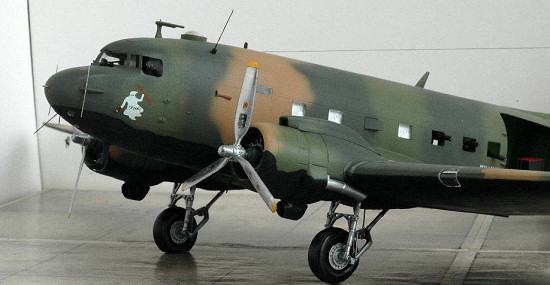 As mentioned in the earlier kit build
the Monogram kit builds easily out of the box. Look for construction challenges
in the wing to fuselage join, the closing of the two fuselage halves and in the
cockpit glazing. The biggest problem for me was joining the two fuselage halves
due to a slightly oversized internal component. Try dry fitting parts 71, 47,
18, 68, 48 and 75 testing for a fit problem after each component dries. My
solution was to file the edges of these parts where there would be contact with
the fuselage. Also, if you cut back on the edge of part 67 (which is the cabin
floor near where the part number is molded on part 67) this will allow the
bottom of the fuselage to close more easily behind the junction with the wing
trailing edge.
As mentioned in the earlier kit build
the Monogram kit builds easily out of the box. Look for construction challenges
in the wing to fuselage join, the closing of the two fuselage halves and in the
cockpit glazing. The biggest problem for me was joining the two fuselage halves
due to a slightly oversized internal component. Try dry fitting parts 71, 47,
18, 68, 48 and 75 testing for a fit problem after each component dries. My
solution was to file the edges of these parts where there would be contact with
the fuselage. Also, if you cut back on the edge of part 67 (which is the cabin
floor near where the part number is molded on part 67) this will allow the
bottom of the fuselage to close more easily behind the junction with the wing
trailing edge.
I solved the fuselage to wing join problem by using a number of Squadron sheet styrene (SQ9001) .020 X .060 plastic strips as “shims” to fill in the gap. Using them and some Testors liquid glue (#3502) I closed the gaps. When this was dry I followed up with some cyanoacrylate glue which I sanded using Squadron sanding sticks and some Flex-I-file sanders.
Additional components that I added
were the Squadron - #48052 resin wheels, Monogram B-17G props and a cut into
the fuselage for a navigator window and the new minigun window opening. The
AC-47D gunship requires a side navigation window. It is not part of the Monogram
C-47 fuselage. The resin wheels were attached using a metal rod (using a
straightened paper clip). I drilled through the Monogram kit landing gear where
the kit wheels attach and used the metal rod as an axle for strength and to
eliminate any landing gear to resin wheel contact issues.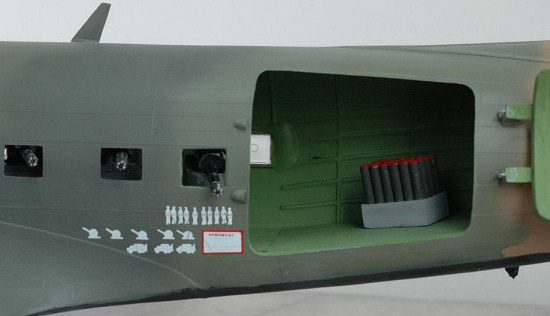
I had to replace the kit props since the kit provides only one style of WWII thin blade props. After I built the first two FC/AC-47D gunships I concluded the best interim solution to the wrong prop dilemma was to use Monogram B-17G props until some after-market replacements are available. The reference texts clearly show the use of paddle shaped props and they are finished in natural metal on the planes featured on the Microscale decal sheet and not the traditional flat black C-47 props found on most aircraft. The props were painted Alclad II duraluminum per color photos on pg. 120 + 122 International Air Power Review. The most important cockpit area enhancements were the Cutting Edge resin gunsight and some scratchbuilt metal wiper blades on the front cockpit windows.
There are many antennas on the top
and bottom of the FC/AC-47 aircraft with no one standard so you need to study
your reference photos. Cutting Edge though provides most of the needed antennas
in their resin set. Page 10 of the Gunships – A Pictorial History of Spooky –
Larry Davis - Squadron Signal publications # 6032 has an excellent diagram of
where you need to look on your reference photos for antennas and other
components that attach to the fuselage. For example, if you look closely at the
nose of the aircraft you will see a small metal loop that appears to be a tow
hook. It is actually the Glide Path Indicator Sensor. The second antenna
research issue concerns the exact configuration of the radio ante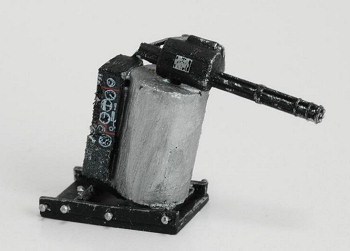 nna wires which
appear under the cockpit cabin area. They are connected to the “L” shaped pitot
tubes that extend prominently below the cockpit cabin stretching back as single
or extended loop aerials.
nna wires which
appear under the cockpit cabin area. They are connected to the “L” shaped pitot
tubes that extend prominently below the cockpit cabin stretching back as single
or extended loop aerials.
I scratch-built the GE MXU-470 guns from basswood and plastic card adding some caliber35 and Verlinden Resin Nuts and Bolts (#0075). I added a placard from Eduard to the 7.62 gun mechanism and dials and instruments to the control box attached to the MXU-470 from an old Monogram WW II instruments decal sheet.
Additional detailing parts incorporated into the kit build were:
1) M.V. Products Light Lens for the wing landing lights
2) Squadron True Details #26008 Authentic Ammo Belts in 1/48th scale.
| COLORS & MARKINGS |
I used Gunze acrylics for the SEA camouflage sealed with Future floor wax and Testors Dullcote. The cockpit and internal fuselage were painted Zinc Chromate Green using Testors Acryl acrylics.
The propellers were natural metal based on color reference photos from International Airpower Review Vol. 4 “USAF Gunships in Vietnam Part 1”. I used Alclad II duraluminum for the props. The antenna wire was made from invisible sewing thread painted with Tamiya flat black. Other antenna wires were made from stainless steel guitar wire courtesy of one of my sons. Guitar wires have a special rigidity that works well for certain applications like this one.
Decals:
The decal is a Microscale (pre-Superscale) 48-251 sheet, Gunships AC-47’s and AC-130A, decal # 1.
Some stencils were taken from the Monogram C-47 kit and my spares box which is mostly Aeromaster decals. I look forward to a reissue of the Superscale 48-251 decal with some additions such as the red “beware of props” stencil and other AC-47 specific stencils.
| FINAL CONSTRUCTION |
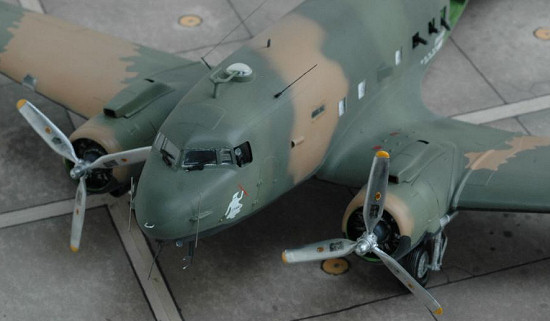 I listed all the references I read
and reviewed in the prior article. Although they all helped with a variety of
C-47 questions and AC-47 gunship derivations, I failed to use two additional
references I had on hand until working on this aircraft version. The two
additional references, one by Jack Ballard and the Larry Davis “C-47 In Action”
are applicable to all three aircraft and highly recommended. They are in the six
key references list that follows. The best color photos and references were
found in International Airpower Review Vol. 4 “USAF Gunships in Vietnam Part 1”
page 116. A color profile of this aircraft can be found in Gunships – A
Pictorial History of Spooky – Squadron Signal publications # 6032 on page 25,
and a photo on page 7. Both references are authored by Larry Davis. They made
this kit build possible. While preparing this article, I was pleasantly
surprised to find a complete conversion and restoration of a DC-3C to an AC-47D
gunship. It can be found at the Aero Heritage Museum in Burleson, Texas, USA.
Color photos and information on this aircraft can be found in the Challenge
Publications magazine, Warbirds International, Vol. 21 Number 6
November/December 2002 pages 37-39.
I listed all the references I read
and reviewed in the prior article. Although they all helped with a variety of
C-47 questions and AC-47 gunship derivations, I failed to use two additional
references I had on hand until working on this aircraft version. The two
additional references, one by Jack Ballard and the Larry Davis “C-47 In Action”
are applicable to all three aircraft and highly recommended. They are in the six
key references list that follows. The best color photos and references were
found in International Airpower Review Vol. 4 “USAF Gunships in Vietnam Part 1”
page 116. A color profile of this aircraft can be found in Gunships – A
Pictorial History of Spooky – Squadron Signal publications # 6032 on page 25,
and a photo on page 7. Both references are authored by Larry Davis. They made
this kit build possible. While preparing this article, I was pleasantly
surprised to find a complete conversion and restoration of a DC-3C to an AC-47D
gunship. It can be found at the Aero Heritage Museum in Burleson, Texas, USA.
Color photos and information on this aircraft can be found in the Challenge
Publications magazine, Warbirds International, Vol. 21 Number 6
November/December 2002 pages 37-39.
The best Gunship references starting
place would be Hurlburt AFB in the Fort Walton Beach, Florida area near Eglin
AFB the birthplace of the gunship. “ Hurlburt Field is a base with unique
challenges and a very special job to do. "Any Time...Any Place" is the motto of
the
16th Special Operations Wing, the host unit at Hurlburt Field. As key
players in such military contingencies as the capture of Manuel Noriega in
Panama, Operation Desert Storm, Operation Provide Hope in Somalia, Operation
Uphold Democracy in Haiti and operations Deny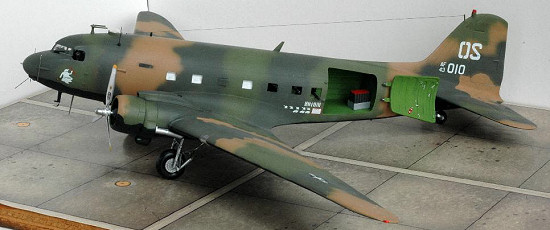 Flight and Joint Endeavor in the
former Yugoslavia, the airmen of the 16th SOW have proven their
motto to be true.” They have an AC-47 Gunship on display (on loan from the USAF
Museum) with the tail code of OS 510 (AF-43510). This aircraft features the
“Spooky” nose art and final color-scheme and weapons configuration of the last
series of AC-47 gunships used in Vietnam.
Flight and Joint Endeavor in the
former Yugoslavia, the airmen of the 16th SOW have proven their
motto to be true.” They have an AC-47 Gunship on display (on loan from the USAF
Museum) with the tail code of OS 510 (AF-43510). This aircraft features the
“Spooky” nose art and final color-scheme and weapons configuration of the last
series of AC-47 gunships used in Vietnam.
This version used the white Kevlar anti-ballistic shroud inside the fuselage to slow down or stop small arms and anti-aircraft fire, which was a fact of life for this aircraft. Despite its awesome firepower it was slow and vulnerable to ground fire. As a result of this ever present danger a white Kevlar cloth was hung inside the fuselage and was visible through the windows. I used some plain white bond paper glued inside the fuselage over the windows to represent this component. The Meteor Productions resin conversion set provided most of the bits including the gun barrel used for the MXU-470 scratch-built component.
| CONCLUSIONS |
Any reading on USAF gunships has the
built-in tribute for several airmen who deserve the highest praise for their
actions in 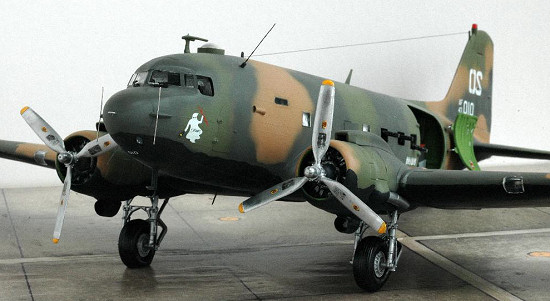 combat. The Medal
of Honor is the highest award for heroism in military action the United States
can bestow upon a member of the Armed Forces. Of the 12 U.S. Air Force
Medal of Honor recipients from the Vietnam War, five were Air Force special
operations Air Commandos.
combat. The Medal
of Honor is the highest award for heroism in military action the United States
can bestow upon a member of the Armed Forces. Of the 12 U.S. Air Force
Medal of Honor recipients from the Vietnam War, five were Air Force special
operations Air Commandos.
William A Jones III, 602nd Special Operations Squadron, Sept. 1,
1968
Bernard F. Fisher, 1st Air Commando Squadron, March 10, 1966
Joe M. Jackson, 311th Air Commando Squadron, May 12, 1968
John L. Levitow, 3rd Special Operations Squadron, Feb. 24, 1969
James P. Fleming, 20th Special Operations Squadron, Nov. 26, 1968
| REFERENCES |
1. International Airpower Review Vol. 4 “USAF Gunships in Vietnam Part 1 pages 112- 125.
2. Gunships – A Pictorial History of Spooky – Larry Davis - Squadron Signal publications # 6032 , 1982.
3. The United States Airforce In Southeast Asia – Development and Employment of Fixed-Wing Gunships 1962-1972 by Jack S. Ballard - Office Of Air Force History, USAF, Washington D.C. 1982.
4. C-47 Skytrain In Action #1149 by Larry Davis – Squadron/Signal Publications 1995
5. Douglas DC-3 Dakota Super Profile – M.J. Hooks – Haynes Publications 1985 Pages 6-7 have a two-page cutaway drawing of the interior components including engine mounts.
6. Douglas DC-3 The Survivors – Kengo Yamamoto Airlife Publishing 2000 - all color photos including two surviving AC-47 museum aircraft on pages 48-49.
Review kit, and decals courtesy of my stash.
April 2006
If you would like your product reviewed fairly and fairly quickly, please contact the editor or see other details in the Note to Contributors.